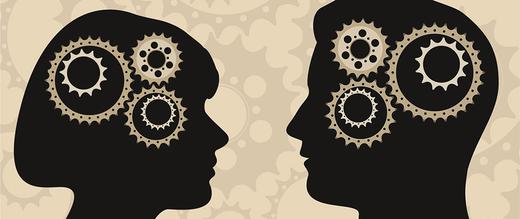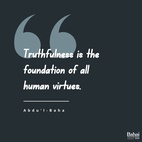The views expressed in our content reflect individual perspectives and do not represent the official views of the Baha'i Faith.
In meaningful conversation, speaking and listening both help achieve the same objective—shared understanding.
Speaking can be thought of as activity and listening as receptivity. Energy is externalized while speaking and internalized while listening. Both involve the flow of energy and information, and differ only in the direction of the flow.
Healing the wounds of our age requires engagement in meaningful conversations. We can reconcile the conflicting visions of reality represented by polarized masculinity or femininity, which may manifest both in conflict between the sexes and mental health problems. Let’s examine some neurological research and a novel that deal with mental health and gender, beginning with this concept—the Baha’i teachings affirm that the soul has no gender:
Sex, in its relation to the exigencies of the physical plane, has no connection with the Spirit. In this age of spiritual awakening, the world has entered upon the path of progress into the arena of development, where the power of the spirit surpasses that of the body. Soon the spirit will have dominion over the world of humanity. – Abdu’l-Baha, Abdu’l-Baha in London, p. 81.
From a Baha’i perspective, there is no difference between the inner spiritual reality of any human being, whether outwardly male or female. Of course, this doesn’t mean that gender is unimportant. Perhaps gender may be seen as the difference in the flow of energy shaped by our physical bodies—men’s bodies direct attention outward, women’s bodies direct attention inward. That gender is associated with how we direct our energies, is now emerging theory in scientific research and the study of autism.

Dr. Simon Baron-Cohen
The APA’s Journal of Abnormal Psychology, as well as a growing body of literature in social work, report that men tend to externalize emotional energy and women tend to internalize it. Conditions relating to an inward focus like depression are more common in women, and those with an outward focus are more common in men. Research from Dr. Simon Baron-Cohen, a British neurologist focusing on gender of the mind and autism, describes autism spectrum conditions (ASC) with his “extreme male brain theory.”
Dr. Baron-Cohen’s research suggests that men’s brains tend to systemize or seek lawful patterns in the external world, while women’s brains tend to empathize with or guess at the internal realities of others’ thought and feeling. According to this theory the autistic brain is called the extreme male brain, because it excels at systemizing but struggles with empathy.
Another notable aspect of Baron-Cohen’s research is his description of this systemizing capacity of the autistic brain as truth-seeking. He says that the autistic mind is well adapted for scientific inquiry into patterns (some of the greatest scientists of our time have autistic or Asperger’s-like characteristics). He suggests:
…if ‘truth’ is defined as lawful patterns in data then, according to the hypersystemizing theory, people with ASC are strongly driven to discover the ‘truth’… their difficulties with empathy are the result of a mind that is seeks the truth in a domain (emotions) that is not very lawful. The truth of another’s feelings is ultimately unknowable and requires representing multiple, different perspectives on reality, rather than a single truth. – Baron-Cohen, The Quarterly Journal of Experimental Psychology, 2008, 61 (1), 64–75.
This research seems to imply that masculinity attunes us externally to the objective; femininity attunes us internally to the subjective. Harvard neurologist Dr. Martha Herbert argues that autism can’t be understood as an object in itself, but rather autism may be understood as the electromagnetic de-tuning of the organism in relation to its environment. We can see from these modern examples, as well as traditional Chinese medicine, acupuncture, and a variety of martial arts, the concept that sickness signals an energy imbalance and equilibrium results in health.
Given that imbalance is present in our culture, what would it mean to move towards greater balance? In the next post in this series, let’s consider how to shift our culture towards health and balance.

















Comments
Sign in or create an account
Continue with Facebookor